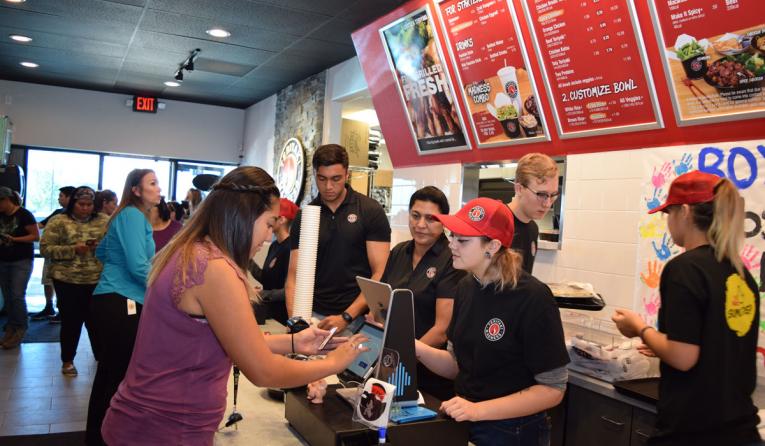Call Sales: +1 (833) 437-3835
Call Sales: +1 (833) 437-3835
Sarah Vancini | April 1, 2022 |

The fastest growing businesses are almost always smaller entities which combine unit growth with same-store sales increases.
For example, in 2019, only one of the 25 fastest growing restaurant chains was listed as in the top 100 largest chains (Shake Shack) and only six of the top 50 fastest growing chains were in the top 100.
However, this trend of small being favored for growth, unexpectedly reversed in the food industry during the pandemic. Large chains ended up dominating the list of fastest growing concepts. Of the 10 fastest growing chains in 2020, seven were part of the 61 largest chains in the US. Four were part of the top 10 chains.
Bigger chains were favored for growth 2020-2021 because of their strong investments in delivery, drive-through and takeout strategies. They also leveraged their well-known brand names and larger marketing budgets during the pandemic.
Larger restaurants had the capital to invest in costly prototypes like curbside and QR codes. The pandemic created years' worth of innovation in off-premises dining options in just months.
With growth rates decreasing for restaurants overall, these bigger chains stood out even more. These assets allowed bigger chains to tackle unheard-of roadblocks impossible for smaller businesses to overcome.
In this article we look at the top growing restaurants during the pandemic, evaluating the strategic moves each entity made and resulting financials.
McDonald's experienced a sixth straight year of positive U.S. same-store sales. In 2020 the overall raise was 0.4 percent.
The brand made some strategic investments which boosted its growth in 2020. Their drive-thru process was enhanced, cutting the throughput time by 30 seconds and moving an additional 300 million cars the past year.
The firm also invested in digital sales, where it earned more than $10 billion across its top six markets. This accounted for about 20% of total revenue.
In addition, McDonald's invested $1.5 billion to open around 1,000 restaurants globally and update around 900 U.S. stores.
In 2021 McDonald's spent around $2.3 billion in modernizing and opening new restaurants. Half of this capital was allocated to opening 1,300 venues globally and $500 million was used to update 1,200 U.S. restaurants. The brand's goal for the next year is to complete 90 percent of their modernization projects.
Starbucks planned to close 500 U.S. and 300 Canadian cafés. This was a strategic move to ensure room for development of new, more efficient retail store formats like Starbucks pickup locations, drive-thrus and stores without seating. Their overall goal was to create stores that cater to customers’ increasing desire for convenience.
Mobile orders became a staple for Starbucks as they invested in app upgrades and increased messaging across marketing channels about their app.
In addition, Starbucks rolled out curbside pickup at 800 locations and began testing handhelds in the drive-thru. Their rewards program also experienced record growth to nearly 23 million members. This growth was aided by the loyalty program’s revamp and inclusion of multiple tiers.
Interestingly the coffee shop has also invested in an artificial intelligence (AI) program named Deep Brew.
COVID created unprecedented long lines for fast food drive thrus. Chick-fil-A took on the challenge of improving operations by setting up multiple-lane drive thrus that were not only efficient but delivered the brand’s guest experience and hospitality.
As well, the firm has invested in robotic delivery tests and created a delivery-only concept in Nashville. Chick-fil-A continues to explore modular construction with its first modular shop opening in Georgia last October.
Taco Bell also leveraged a new advanced point of sale (POS) system. This system is a modern, tablet-based application that’s completely customizable. In addition, Taco Bell plans to open a series of new models like drive-thru cantinas and 1,000 “bellhops.”
In 2020 Wendy’s responded to the pandemic by decreasing their marketing budget. In spite of that, Wendy's closed 2020 with its two highest global same-store sales quarters in the past 15 years.
Pizza Guys reaped the benefits of strong demand for pizza in 2020. Its average unit volumes rose 16% and it added three locations.
Marco’s Pizza, the fastest-growing pizza chain is expected to overtake Papa Murphy’s to become the fifth largest pizza chain in the U.S. in coming years.
Sonic surpassed both Pizza Hut and Panera Bread. With pandemic restrictions, Sonic’s drive-ins were the perfect option.
Teriyaki Madness grew rapidly in 2020 through franchising.
A clear differentiator between companies that overcame hardships during the pandemic to experience growth and those that could not innovate to survive was the degree to which they invested in technology.
From genius rewards program revamps to new contactless ordering options to state-of-the-art apps, chain restaurants that developed such infrastructure programs are now thriving even as restrictions are lifted.
America's appetite for digital services has not weaned since 2020. People still prefer these delivery and to-go options over traditional dine-in scenarios. Even as new concepts emerge, robust technology investment is still a must.
Creating such technological innovations can be costly and time consuming. But with the right technology already in place, like Revel’s cloud-native POS platform, operators can seamlessly integrate with various vendors providing enhanced rewards programs, digital innovations, contactless kiosks and more. This is a great first step into affordable investment in consumer-friendly tech.
Start investing in your franchise's success and explore a free demo of Revel's POS platform today.